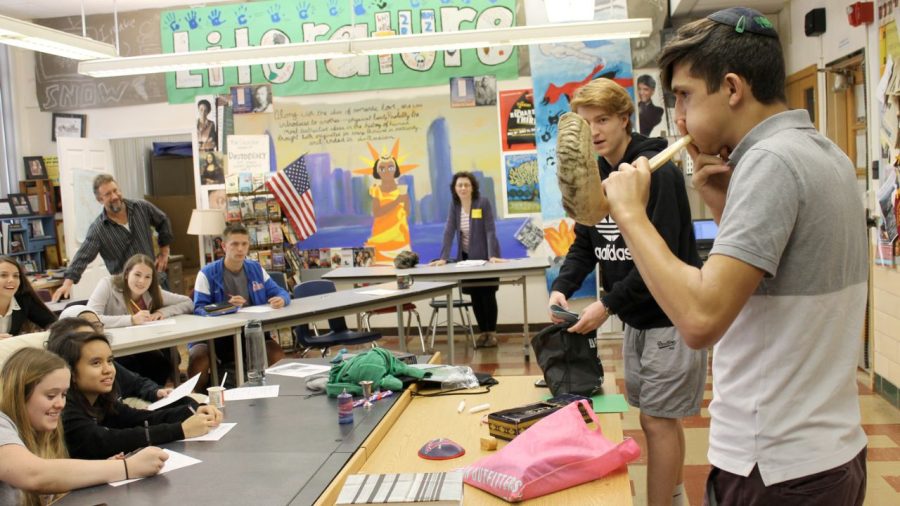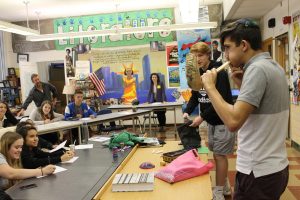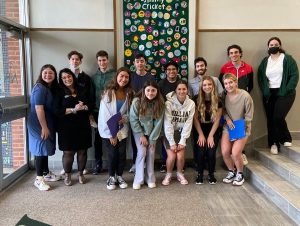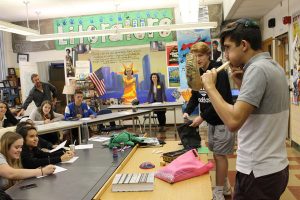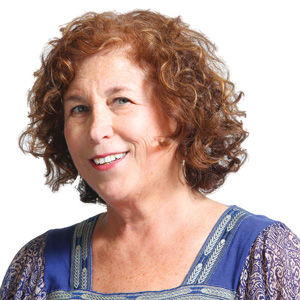St. Louis Jewish teen peer-to-peer program expanding in US
In a 2017 file photo, David Feit Mann, then a sophomore at Yeshiva Kadmiah High School, closed a Student to Student presentation for an AP English class at Affton High School by explaining how a ram’s horn is used in Judaism. Photo: Eric Berger
Published August 24, 2022
Be the Narrative, a new Jewish national nonprofit based in St. Louis plans to build on the success of its flagship educational program, Student to Student, and continue to replicate it in cities nationwide.
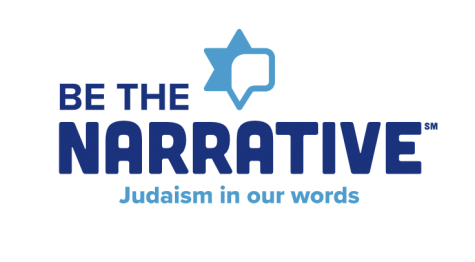
“We know there continues to be tremendous interest from other cities in the Student to Student program,” said John Kalishman, co-founder with Joe Pereles of Be the Narrative. “We expect that will only continue as we are much more visible.
ADVERTISEMENT
“We also know that as a Jewish community, we are very interested collectively in reaching teens past their bar and bat mitzvah years. This is a such a wonderful program for engaging Jewish high school students in a way that they feel they can really make a difference.”
Student to Student, which was begun 30 years ago in St. Louis by the Jewish Community Relations Council (JCRC), sends Jewish high school juniors and seniors to schools whose students have littleto- no contact with Jews. By listening to Jewish teens from the Reform, Conservative, Orthodox and Recontructionist movements, as well as the unaffiliated, and asking them questions about their Jewish identity, traditions, values and practices, students who are unfamiliar with Judaism can learn about the religion.
During the 2021-2022 school year, despite a global pandemic, 304 Jewish teens made presentations to 6,808 non-Jewish teens at 91 public and private high schools.
Research, including a study conducted by LS Associates in 2019, shows that students who attend Student to Student presentations demonstrate a better understanding of Jews and Judaism, which in turn can help dispel stereotypes and combat prejudice and antisemitism.
ADVERTISEMENT
“Student to Student is more important today than it’s ever been, given the divisiveness across our country,” Pereles said. “The fact that the program helps break down stereotypes and has peers talk to peers is so important going forward.”
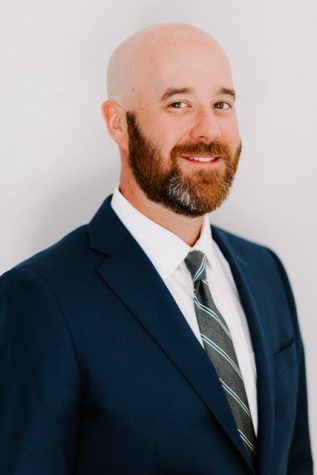
Rabbi Andrew Terkel, 36, the new CEO of Be the Narrative, says the peer-to-peer component that is the cornerstone of Student to Student is what most attracted him to the job. His wife, Hannah Rubin- Schlansky, 36, grew up in St. Louis (her family still lives here), and was a Student to Student representative when she attended Clayton High School. She is the assistant director of Washington University Hillel.
Terkel grew up in Broken Arrow, Okla., where, as you might guess, his was the only Jewish family. His father owned several bakeries in town.
“Reading the Student to Student program description resonated with me a lot as a Jew from a really small town,” he said. “Even as a kid, I was asked questions about Judaism by my classmates and teachers. I needed to be the representative of the Jewish people whether I wanted to be or not. I was the only one there.”
Nonetheless, being that “personal, friendly representative of Judaism and the Jewish people and Jewish history” is what he finds unique about Student to Student and why he is excited to continue to strengthen it, expand the program to other cities and make sure it is sustainable.
“These teens are putting a face to what otherwise might be foreign and strange and mysterious,” he said. “It’s a lot to put on them, but I think the training we offer, and the earnest and honest nature of teen peer-to-peer conversation, can be really powerful.”
Growing Student to Student takes root
From 2017 to 2020, the JCRC used $45,000 in grants from the Natan Fund, a national Jewish organization, to help Student to Student expand to nine cities, including Indianapolis; Washington, D.C.; Chicago; Dallas; Seattle; and Charlotte, N.C. Most of these programs are run through local federations or JCRCs.
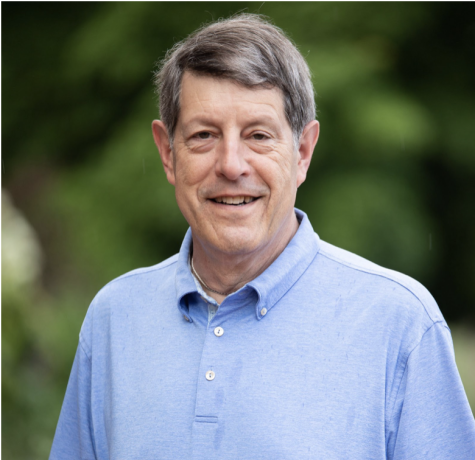
Kalishman and Pereles, both former board chairs of the St. Louis JCRC, knew firsthand the success of Student to Student and its positive impact on Jewish student representatives and their non-Jewish student audiences. They also felt that in order to expand the program and ensure continued success, it needed an umbrella nonprofit organization to bring Student to Student to a national arena.
“Managing a local program is different from undertaking a national expansion,” Kalishman said. “We recognized that meeting growing demand would require resources and skills that were beyond the scope of our local JCRC.”
He and Pereles, with input from Fawn Chapel, who has been involved with the Student to Student program here since 2003, created a business plan and applied for 501c3 status. They fundraised and started to assemble a board of directors.
In December, when they brought their proposal to the JCRC board, its members agreed to transfer all “licenses and intellectual property” to this new national nonprofit, which first was called Student to Student Inc. but is now Be the Narrative.
The new name, with its tagline “Judaism in our words,” refers to the students who “tell their stories and add to the narrative” about what it means to be Jewish, Pereles said.
Be the Narrative
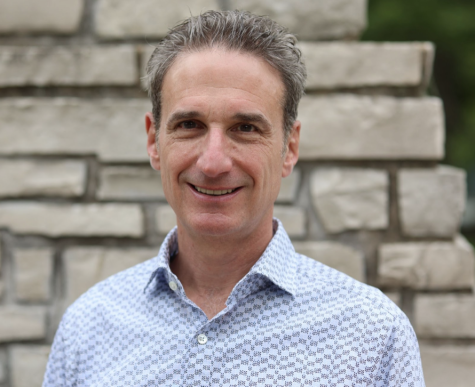
“From the get-go, we envisioned having a new national organization that would lead the Student to Student program. We wanted to distinguish the national organization from the local Student to Student programs and give ourselves a platform for more programs in the future that would allow us to be more than Student to Student,” said Kalishman.
“Strategically, it was important to have our own brand and own name that would allow us to invest in Student to Student and yet create our own identity.”
Be the Narrative is rolling out Student to Student to new licensees in Boston, Detroit, Nashville, Tenn., and Bloomington, Ind., bringing the total number of cities operating the program to 13. Chapel will continue in her role as national program coordinator, reporting to Terkel.
Next month, from Sept. 11-13, Be the Narrative will host its first national conference and bring Student to Student program leaders from around the country to St. Louis to learn from one another, build camaraderie, discuss best practices, and compare and develop strategies to help ensure the program’s continued success.
Terkel says he is less concerned about growing the program quickly, targeting instead “modest, intentional, sustainable growth.” Kalishman and Pereles concur.
“We want to make sure our attention now is on helping our existing cities expand their programs and making sure they have the resources they need while at the same time selectively adding additional cities,” Kalishman said.
“Now that our website is up and available, it will be a helpful marketing tool. We get inquiries all the time not only from larger cities but smaller ones, too. We have tremendous growth opportunities, which might cause us to look at different delivery methods in the future as we reach areas that don’t have large Jewish populations.”



